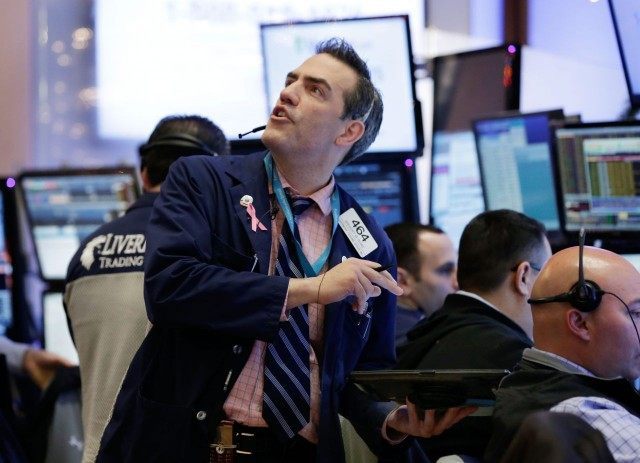NEW YORK (AP) — The new year got off to an inauspicious start on Wall Street as stocks tumbled Monday in a global sell-off triggered by new fears of a slowdown in China and rising tensions in the Middle East.
The Dow Jones industrial average clawed back from a steep early decline but still ended the day down 1.6 percent, its biggest drop in two weeks. Markets in Asia and Europe suffered heavier losses.
The wave of selling on the first trading day of 2016 served as a reminder that the global worries that weighed on financial markets last year are not going away anytime soon.
“It’s going to be a turbulent year,” said Kevin Kelly, chief investment officer of Recon Capital Partners. “This isn’t a blip.”
The trouble started in China, the world’s second-largest economy, where signs of manufacturing weakness sent the Shanghai Composite Index plunging 6.9 percent before Chinese authorities halted trading by using a new “circuit-breaker” mechanism for the first time.
Investors were also unnerved by heightened tensions between Saudi Arabia, a huge oil supplier, and Iran. Saudi Arabia severed diplomatic relations over the weekend in a dispute over the Saudis’ execution of a Shiite cleric.
In the U.S., the Dow slumped 276.09 points to 17,148.94. It was down as much as 467 points earlier in the day.
The Standard & Poor’s 500 index lost 31.28 points, or 1.5 percent, to 2,012.66. The Nasdaq composite fell 104.32 points, or 2.1 percent, to 4,903.09.
The selling in China spread quickly across markets in other Asian countries, then to Europe. Key indexes fell anywhere from 2.2 percent to 4.3 percent in Japan, Hong Kong, South Korea, Germany, France and Britain.
Huang Cengdong, an analyst for Sinolink Securities in Shanghai, said he expects more turmoil in the Chinese stock market ahead of corporate earnings reports. “There will be heavy selling in the near future,” Huang said.
The immediate trigger of the sell-off was a report that showed that manufacturing in China fell in December for the 10th straight month.
The slowdown is worrisome around the globe because China’s manufacturers are huge buyers of raw materials, machinery and energy from other countries. Also, many automakers and consumer goods companies are hoping to sell more to increasingly wealthy Chinese households.
In the U.S., slow overseas growth already appears to be hurting American manufacturers. A report issued Monday by the Institute for Supply Management showed manufacturing contracted last month at the fastest pace in more than six years as factories cut jobs and new orders shrank.
Chinese authorities have been trying for months to restore confidence in the country’s market after a plunge in June rattled global markets and prompted a panicked, multibillion-dollar government intervention.
Ernie Cecilia, chief investment officer of Bryn Mawr Trust, warned that investors shouldn’t overreact to Monday’s drops.
“A weak first day of the year doesn’t portend that 2016 will be a down year,” Cecilia said. “There are a lot of trading days left.”
The escalating tensions between Saudi Arabia and Iran briefly sent the price of oil surging. Benchmark U.S. crude fell 28 cents to close at $36.76 a barrel on the New York Mercantile Exchange.
“Oil markets will be concerned that this could be an incremental step in a deteriorating political situation that might ultimately threaten world oil supply,” Ric Spooner, chief analyst at CMC Markets, said in a commentary.
Bond prices rose, sending yields lower. Investors tend to park money in U.S. government bonds when they are fearful of weak economic growth or turbulence in stocks and other markets. The yield on the 10-year Treasury note fell to 2.24 percent from 2.27 percent.
In metals trading, gold rose $15 to $1,075.20 an ounce, silver lost 4 cents to $13.84 an ounce, and copper fell 6 cents to $2.08 a pound.
Brent crude, the international standard, edged down 6 cents to close at $37.22 a barrel in London.
In other energy trading in New York, wholesale gasoline rose 2 cents to $1.291 a gallon, heating oil rose a quarter of a cent to $1.126 a gallon, and natural gas edged down 0.3 cent to $2.334 per 1,000 cubic feet.
___
AP Business Writer Youkyung Lee in Seoul, South Korea, and AP researcher Fu Ting in Shanghai contributed to this story.

COMMENTS
Please let us know if you're having issues with commenting.